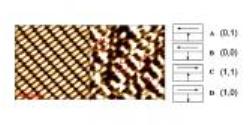A French research team has discovered how to increase areal density of data two-fold by fragmenting the magnetic medium into nano-particles to create a three-dimensional tower.
The technique improves data density that could be saved in a magnetic device, and how to reach out beyond a physically limiting barrier. The research paper appears in the American Institute of Physics' Journal of Applied Physics.
 AIP's Atomic force and magnetic microscopy images of two-bit patterned media for data storage
AIP's Atomic force and magnetic microscopy images of two-bit patterned media for data storage
According to Jerome Moritz, a researcher at SPINTEC in Grenoble, the areal density is now 500Gbit/in2, and the technology involves writing the data on a granular magnetic material. But these grains are becoming smaller, making their magnetization unreliable leading to a slow deletion of the data.
The team has used bit-patterned media made up of arrays of magnetic nanodots that have been physically separated. One nanodot transports one data bit. The number of bits per dot can be increased to enhance the density of the data being stored by piling multiple magnetic layers in order to create a multilevel recording platform that displays magnetic qualities.
The 2-bit-per-dot media involves piling the magnetic layers both linearly in-plane and perpendicular-to-plane over each dot. It is possible to read the perpendicular layer exactly over the dot, while the linear in-plane layer allows reading only between dots. This increases the areal density for a specific dot two-fold by using the entire patterned material surface.